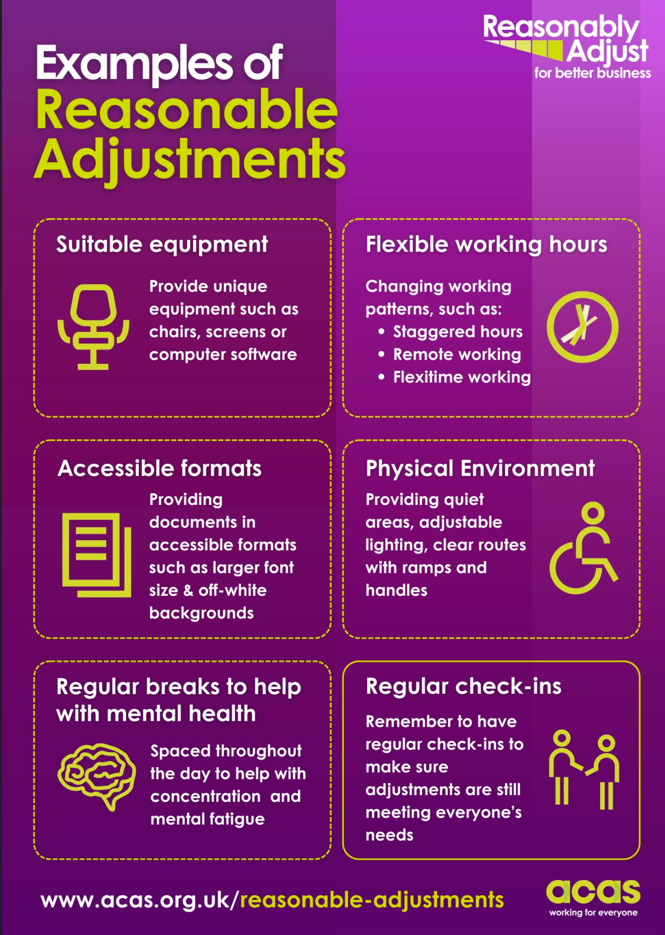

A reasonable adjustment is a change an employer makes with a view to removing or reducing a substantial disadvantage related to someone’s disability.
The duty to make reasonable adjustments arises (a) where an employee or job applicant has a “disability” within the meaning of that term under the Equality Act 2017 (b) who, by virtue of that disability, is placed at a substantial disadvantage in comparison with colleague(s) or other job applicants who are not disabled. An individual is “disabled” if they have a physical or mental impairment which has a substantial and long-term adverse effect on that person’s ability to carry out normal day-to-day activities (see article on Disability).
The aim of the duty to make reasonable adjustments is to remove barriers to disabled people participating in work and to “level the playing field”.
The duty to make a reasonable adjustment does not arise unless the disabled person is placed at a “substantial disadvantage” because of their disability. Whether an individual is substantially disadvantaged in comparison to a person who is not disabled is a question of fact for the employment tribunal to determine. However, the employee only needs to show that the disadvantage is more than “minor or trivial”. In reality, it is a relatively low bar and so it is not difficult for an employee or job applicant to establish that the disadvantage is “substantial”.
More specifically, an employer’s duty to make reasonable adjustments arises where the individual is disabled AND is placed at a substantial disadvantage by virtue of one of the following:
- a provision, criterion or practice (commonly abbreviated to “PCP”) – that is any working practice, policy or rule implemented by the employer;
- a physical feature of the employer’s workplace or premises; or
- an employer’s failure to provide an auxiliary aid.
The duty will not apply unless the employer knows or ought reasonably to know that the person has a disability and is likely to be placed at a substantial disadvantage because of such disability.
We consider each of the specific provisions or issues in relation to which a duty to make reasonable adjustments may arise further below.
Provision, criterion or practice (PCP)
PCPs are not defined in law and are deliberately broad to capture all types of disadvantage people with disabilities may face including “any formal or informal policies, rules or practices and can include “one off” management decisions or actions”.
For example, an employer has a policy of only giving designated car park spaces to senior managers. A junior employee has a disability and needs to park closer to the office. The PCP is the employer’s parking policy which allocates designated parking spaces close to the office to senior managers. However, the junior employee, being unable to walk longer distances, is placed at a substantial disadvantage in comparison with colleagues who can walk more easily. In the circumstances, the duty to make a reasonable adjustment is triggered (assuming knowledge etc) and it is likely to be a reasonable adjustment to give the junior employee a designated car parking space. Not doing so may give rise to a claim for failure to make reasonable adjustments.
Physical feature
The duty to make reasonable adjustments can arise where a physical feature of the employer’s premises puts a disabled person at a substantial disadvantage in comparison with those who are not disabled.
Physical features can include:
- the design or construction of a building;
- the approach to, exit from, or access to a building;
- a fixture or fitting, furniture, furnishings, materials or equipment; or
- any other physical element or quality.
A reasonable adjustment may include removing the feature, such as a rug which impedes wheelchair users, or altering a doorway to make it wider to accommodate a wheelchair. Other examples may include placing colourful stickers on internal doors made of clear glass panels to assist employees who are visually impaired so as to make the hazard stand out.
Auxiliary aid
Where a disabled person would, but for the provision of an auxiliary aid, be put at a substantial disadvantage in comparison with those who are not disabled, the employer must take such steps as are reasonable to provide the auxiliary aid. An auxiliary aid is a specialist piece of equipment (eg an adapted keyboard or voice activated software for visual impairments) which addresses the impact of a disability. The definition can include auxiliary services such as a sign language interpreter for an employee with a hearing impairment. That is not to say it would necessarily be required for an employer to provide a full-time sign language interpreter, but there may be occasions when an auxiliary service is reasonable to provide.
Long term sickness absence (a form of PCP)
Sickness absence or attendance management policies which require employees to maintain a certain level of attendance at work could well place disabled employees who have absences related to their disability at a substantial disadvantage compared with non-disabled employees. Such policies will therefore be subject to the duty to make reasonable adjustments. The requirement to make reasonable adjustments does not mean an employer has to ignore the disability related absence completely when managing absence of disabled employees but the employer should consider whether any adjustments ought to be made when applying the policy.
For example, an employee has depression and high levels of sickness absence. The employer requires consistent attendance at work (a PCP) which puts the employee at a substantial disadvantage compared with other non-disabled employees. The duty to make reasonable adjustments arises. Before taking any formal action, the employer may wish to refer the employee to occupational health to get up-to-date medical advice on the employee’s capabilities and any reasonable adjustments that might improve attendance. In considering implementing any adjustments and their reasonableness, the employer is entitled to bear in mind not only their duties towards the disabled employee but also the impact of the absence on the team and service levels.
Each case will be fact sensitive, but the employer should be cautious before proceeding with a formal process (capability/performance) where disability may be an underlying factor. In such circumstances, advice should be sought so as not to expose the employer to a claim for failing to make reasonable adjustments or for related discriminatory acts.
Is the adjustment “reasonable”?
There is no onus on a disabled person to suggest adjustments. This obligation falls on the employer, together with the costs of making any such reasonable adjustments (ie the cost cannot be passed on to the individual concerned).
The reasonableness (or otherwise) of an adjustment if for the employment tribunal to determine. The tribunal will take into account, amongst other factors, whether the adjustment is likely to remove or reduce the disadvantage, the cost of making the adjustment (bearing in mind the size of the employer and its financial resources) and the availability of external financial or other assistance as well as any disruption the adjustments would have on the employer’s activities and the extent to which the adjustment is practicable.
Common misconceptions…
There is a common misconception that disabled employees can ask for any changes they like on the premise that it would constitute a “reasonable adjustment” which is simply not the case – the duty only arises in specific circumstances outlined above and it must be reasonable. For example, asking for an increased salary or larger office space would be unlikely to constitute a reasonable adjustment.
Top tips to manage reasonable adjustments
- Train managers to identify and implement or, if not possible directly, seek advice on disability adjustments for job applicants as well as existing staff. Remember that a reasonable adjustment may be required at various stages of the employment relationship including when handling disciplinary and grievance cases and in applying various workplace policies or undertaking restructuring/workforce redeployments eg absence management, redundancy selection and so on
- Signpost sources of information and support for managers to assist them in making reasonable adjustments.
- Engage with disabled employees about reasonable adjustments; ask them individually what they need but don’t be afraid to seek advice from a healthcare professional as to the utility or likely effectiveness of proposed measures.
- Create a flexible mindset and approach to making accommodations in working practices and environment, where reasonable – this may be helpful in avoiding claims for indirect discrimination on the basis of other protected characteristics such as sex, pregnancy and maternity etc.
__________________________________________________________________________________________________________________
Useful Resource:-
The below graphic is published by, and is copyright of, Acas (ie it is UK guidance, but still of relevance to the Isle of Man) and comprises a handy reference guide to reasonable adjustments. Please be aware that our note above and any views or advice included within it are not endorsed by Acas.
